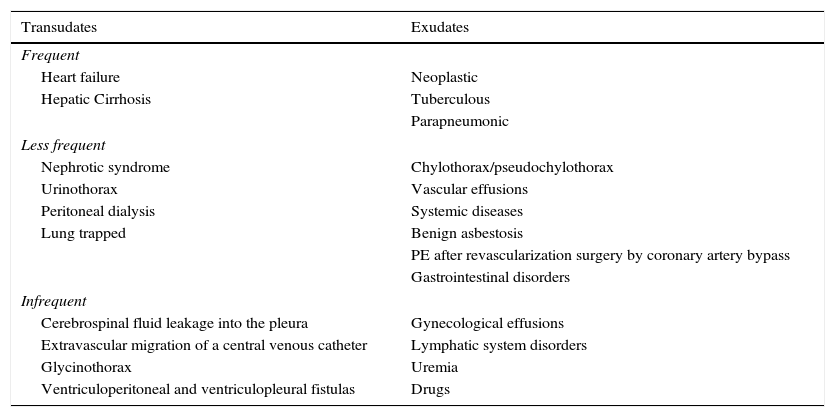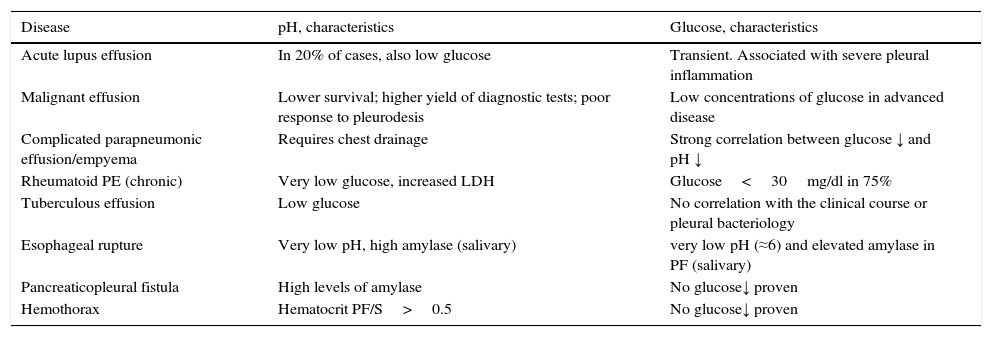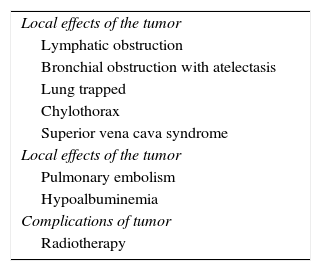Analysis of pleural fluid can have, on its own, a high diagnostic value. In addition to thoracocentesis, a diagnostic hypothesis based on medical history, physical examination, blood analysis and imaging tests, the diagnostic effectiveness will significantly increase in order to establish a definite or high probable diagnosis in a substantial number of patients.
Differentiating transudates from exudates by the classical Light's criteria helps knowing the pathogenic mechanism resulting in pleural effusion, and it is also useful for differential diagnosis purposes. An increased N-terminal pro-brain natriuretic peptide, both in the fluid and in blood, in a due clinical context, is highly suggestive of heart failure.
The presence of an increased inflammatory marker, such as C-reactive protein, together with the presence of over 50% of neutrophils is highly suggestive of parapneumonic pleural effusion. If, in these cases, the pH is <7.20, then the likelihood of complicated pleural effusion is high. There remains to be demonstrated the usefulness of other markers to differentiate complicated from uncomplicated effusions. An adenosine deaminase >45U/l and >50% lymphocytes is suggestive of tuberculosis.
If a malignant effusion is suspected but the cytological result is negative, increased concentrations of some markers in the pleural fluid can yield high specificity values. Increased levels of mesothelin and fibruline-3 are suggestive of mesothelioma. Immunohistochemical studies can be useful to differentiate reactive mesothelial cells, mesothelioma and metastatic adenocarcinoma.
An inadequate use of the information provided by the analysis of pleural fluid would results in a high rate of undiagnosed effusions, which is unacceptable in current clinical practice.
El análisis del líquido pleural, por sí mismo, puede tener valor diagnóstico. Pero si además de hacer una toracocentesis se establece una hipótesis diagnóstica con base en la historia clínica, la exploración física, el análisis de sangre y las pruebas de imagen, la rentabilidad diagnóstica aumentará de forma relevante y se podrá establecer un diagnóstico definitivo, o de alta probabilidad, en un elevado porcentaje de pacientes.
Diferenciar entre trasudados y exudados, clásicamente a través de los criterios de Light, ayuda a conocer el mecanismo fisiopatológico por el que se produce el derrame pleural, y a estrechar su diagnóstico diferencial. Un valor elevado del fragmento N-terminal del propéptido natriurético cerebral, tanto en líquido como en sangre, en un marco clínico adecuado, es muy indicativo de fallo cardiaco.
Un marcador inflamatorio elevado, por ejemplo la proteína C reactiva, junto con más de un 50% de neutrófilos, revela muy posiblemente un derrame paraneumónico. Si, en estos casos, el pH es<7,20, existe una alta probabilidad de que el derrame se esté complicando. Está por demostrar la utilidad de otros marcadores para diferenciar entre derrames paraneumónicos complicados y no complicados. Una adenosina desaminasa>45U/l y más de un 50% de linfocitos es muy indicativo de tuberculosis.
Si se sospecha un derrame neoplásico y la citología es negativa, concentraciones elevadas en el líquido pleural de algunos marcadores son altamente específicas. Altos valores de mesotelina y fibulina-3 evidencian mesotelioma. La inmunohistoquímica puede ayudar a diferenciar entre células mesoteliales reactivas, mesotelioma y metástasis por adenocarcinoma.
Un uso inadecuado de la información que puede proporcionar el análisis del líquido pleural conllevaría un alto porcentaje de derrames no diagnosticados, difícilmente aceptable en la práctica clínica actual.












